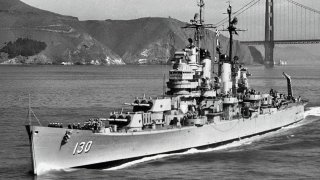Baltimore-Class: What Made These U.S. Navy Heavy Cruisers a Powerhouse
During the Second World War, the U.S. Navy’s Baltimore-class heavy cruisers became the first of their kind to be designed without the limitations of the London Treaty.
USS Baltimore primer: During the Second World War, the U.S. Navy’s Baltimore-class heavy cruisers became the first of their kind to be designed without the limitations of the London Treaty.
Outlined in the Treaty for the Limitation and Reduction of Naval Armament, the U.S., UK, Japan, France and Italy agreed to regulate submarine warfare, limit naval shipbuilding and further control cruisers and destroyers. Without these guidelines, the Baltimore ships were better prepared to protect aircraft carriers in battle groups from air attack.
The Baltimore heavy cruisers were partly based on the design of the preceding Cleveland-class light cruiser. However, the Baltimore ships had large guns in three turrets instead of the twelve 6-in guns installed on the Clevelands.
Four Baltime ships were constructed in 1940 and an additional four were ordered by the end of the year. A total of 14 Baltimore-class cruisers were produced.
As detailed by Jane’s Fighting Ships of World War II, the Baltimore heavy cruisers displaced 13,600 tons and a complement of 17,00 sailors. The ships measured roughly 673 feet in length with beans measuring nearly 70 feet long.
The Baltimore-class cruisers were notably longer and more heavily armed than the Royal Navy’s HMS Dreadnought which was introduced as a cutting-edge battleship one generation prior.
Introducing the USS Baltimore:
The lead of the class, USS Baltimore (CA-68) was commissioned at the South Boston Annex of the Boston Navy Yard in 1943. During her first year on the waters, the Baltimore carried out gunnery exercises and training before traveling to Pearl Harbor.
By 1943, the Baltimore was a unit of the fire support and covering forces in the invasion of Maskin Island during the Second World War. Until summer 1944, Baltimore provided fire support in a range of missions, including the invasion of Hallandia, the Palau-Yap-Ulithi-Woleai raid, airstrikes against Marcus Island and the Battle of the Philippine Sea.
What happened to the USS Canberra?
Although no Baltimore-class heavy cruisers were lost during the Second World War, the USS Canberra (CA-70/CAG-2) came the closest when she was torpedoed during the Aerial Battle of the Taiwan-Okinawa.
When the weapon was launched from a Japanese aircraft and struck the cruiser below her armor belt, an explosion erupted. In the aftermath, 23 personnel were killed and the engineering spaces of the ship were exposed to the ocean. Her sister ship, the USS Boston (CA-69) towered her pack to port. The Canberra would later receive seven battle starts for her wartime service.
Following the war, only four of the Baltimore-class cruisers were refitted and converted into the world’s first ever guided missile cruisers. As outlined by Peter Suciu, “USS Columbus (CA-74) became CG-12 and USS Chicago (CA-136) became CG-11 of the Albany -class.
Along with the lead vessel, the converted CA-123/CG-10 – the former Oregon City-class, a modified version of the Baltimore-class, heavy cruiser – these vessels were armed with two Mark 12 RIM-8 Talos missile launchers, two Mark 11 RIM-24 Tartar launchers and one Mark 16 RUR-5 ASROC launcher, along with just two of the original 5-inch (38-caliber) guns.”
About the Author: Maya Carlin
Maya Carlin, National Security Writer with The National Interest, is an analyst with the Center for Security Policy and a former Anna Sobol Levy Fellow at IDC Herzliya in Israel. She has by-lines in many publications, including The National Interest, Jerusalem Post, and Times of Israel. You can follow her on Twitter: @MayaCarlin.


